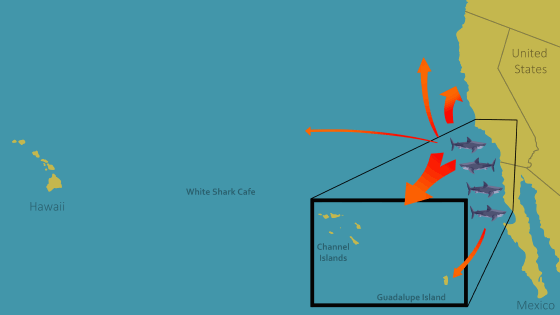It’s well known that the waters off the San Diego coast is a nursery for juvenile great white sharks, but until now, scientists haven’t known how long those baby sharks remain there.
A recent study by the California State University, Long Beach Shark Lab sheds some light on that. The lab has been using acoustic telemetry to track juvenile white sharks for more than a decade.
"We're actually, for the first time, able to see when an individual shark moves from the nursery habitat — when they don't come back to the nursery habitat — to when they move to the adult habitat," said Ryan Logan, the lead researcher for the study. "And that happens right at about the 9- to 10-foot range, which would correspond to about a 4- to 5-year-old shark."
Young-of-the-year sharks — white sharks that are less than a year old — show up in the shallow waters off San Diego and southern California during the summer and fall months. They use these warmer waters as nurseries for the abundant, easy-to-catch prey and to avoid being prey to larger sharks.
"It’s really cool to see all the sharks during the season, like in the waves," said Kelsey Calhoun, who was enjoying the beach at La Jolla Shores with her boyfriend, Erick Lengtat.
Research shows most people aren’t aware that they’re swimming and surfing next to sharks, especially in places like Del Mar, but attacks are rare. The sharks mainly leave people alone.
"So whether they’re here or not, you know, you kind of made that choice when you get in the water," Lengtat said. "So if the water feels good and waves are good, you want to surf and swim."

What this study shows is when baby great whites become "teenage sharks," so to speak, they venture into deeper water. And that’s great news for surfers and swimmers.
"When they get to that 9- to 10-foot range is when they start to transition into feeding on marine mammals, sea lions, seals, harbor seals — things like that," Logan said.
That’s also when they start leaving the most populated beaches, limiting the potential for mistaken identity where sharks mistake surfers for their main prey, he said. Researchers, however, still don't know why great whites go so far offshore when they mature or what they are doing there.
"I think it’s just a beautiful thing that the shark come here and then they leave once they’re ready," Calhoun said.
Logan said knowing how long great white sharks use the nursery will aid scientists in future conservation plans for this population of white sharks and, ultimately, the species. Scientists still don't know where white sharks give birth.






